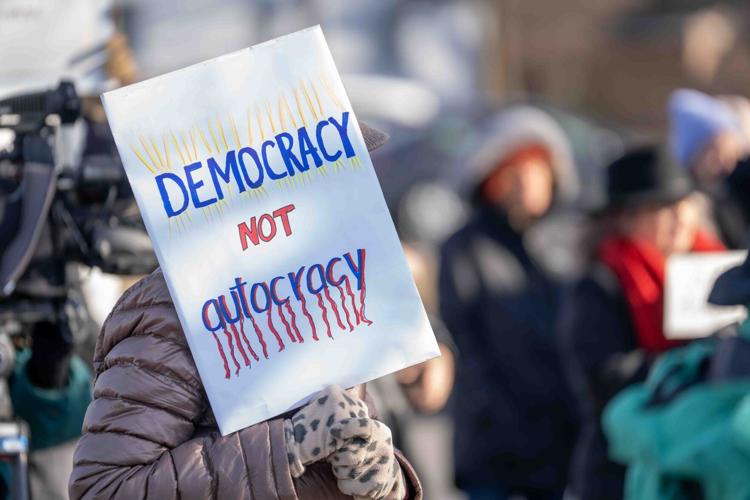Since taking office a little over a month ago, President Donald Trump and his appointees have been unusually active. So unprecedented are their actions, both in scale and scope, that it has been bewildering even for those of us whose job it is to make sense of it all.
The propulsive force behind the flurry of activity is the Department of Government Efficiency, or DOGE. Created by an executive order, DOGE is not an entirely new entity but is, instead, a rebranding of the U.S. Digital Service. That entity was created by President Barack Obama in 2014 with a goal of delivering “better government services to the American people through technology and design.”
What, exactly, is DOGE up to, and what is the basis of its authority? In a Feb. 16 Sunday LNP | LancasterOnline column, U.S. Rep. Lloyd Smucker offered an explanation of DOGE’s purpose, though he avoided any mention of its authority. DOGE, Smucker wrote, is part of President Trump’s “aggressive effort to improve government operations” and it aims “to streamline government operations, root out waste and improve efficiency.”
That all sounds quite reasonable. After all, improving government operations and efficiency sounds a lot like what the U.S. Digital Service was created to do. Indeed, as Smucker notes, a similar effort was undertaken by President Bill Clinton in the 1990s and it received little, if any, resistance.
A brief history of the Clinton reform effort might explain why there was so little resistance. Shortly after the start of Clinton’s first term, in March 1993, the National Performance Review began with a six-month review of government operations. No one was fired during the review; no authorized spending was frozen.
Instead, roughly 250 civil servants from federal government agencies were trained to assess everything from procurement to personnel to budgets. Agencies were also instructed to create their own internal “reinvention teams.” The effort was led by Vice President Al Gore.
A final report was issued in September 1993 and included 384 recommendations, many of which Clinton was able to enact directly. However, the more consequential recommendations required congressional action. This included a recommended reduction in the federal workforce by 252,000 positions over five years (which Congress increased to 272,900).
Much of the workforce reduction would be accomplished by attrition. But employees were also offered buyouts. Unlike DOGE’s voluntary resignation program, however, the Clinton administration sought, and received, congressional authorization for its buyout plan. Indeed, by December 1994, Congress had passed 34 bills enacting recommendations from the National Performance Review report.
If the Clinton effort to reinvent government elicited little resistance, it is because the White House respected the constitutional separation of powers and the authority of Congress.
The DOGE process for “improving government operations” bears little resemblance to that earlier effort.
Embarrassing mishaps
The current process has not included an extensive fact-finding mission and has not enlisted experts in governmental operations. This “shoot first, aim later” approach has led to a number of embarrassing mishaps and is likely to cause significant damage to essential government functions.
For instance, DOGE reportedly fired National Nuclear Security Administration employees, only to frantically try to rehire them when the Trump administration learned that those employees are responsible for safeguarding the nation’s nuclear weapons. Similarly, officials at the U.S. Department of Agriculture who were working to contain the spread of bird flu were abruptly fired only to have their terminations hastily rescinded.
DOGE’s claims to have uncovered instances of fraudulent government spending have either been unsubstantiated or have been shown to be mistaken.
Fifty million dollars for condoms in the Gaza Strip? No, though money was sent to the Gaza province, in Mozambique, for the prevention and treatment of HIV and tuberculosis.
Did the news agency Reuters get millions of dollars for “large scale social deception”? No; a Department of Defense grant went to Thomson Reuters Special Services, an entity that is legally separate from the news organization (and is governed by an independent board of directors). And the purpose of the grant was to defend the country against cyberattacks, not to produce social deception.
Are Social Security checks going to individuals who would be 150 years old according to government records? No; the confusion stems from a quirk of the computer programming language used by the government that sets 1875 as a default birth date in the relatively few instances when data is missing.
In fact, we know how many checks were sent in December to those ages 99 and older: It was 89,106, a figure that is lower than the Census Bureau estimate of the number of centenarians in the United States (101,000).
It is certainly possible that some deceased individuals are still receiving Social Security checks. A system as complex as the Social Security Administration’s will undoubtedly contain mistakes and some dishonest actors will try to take advantage of the cumbersome process of updating databases. But to suggest, as Elon Musk did, that millions of Americans over the age of 100 are potentially receiving Social Security checks is absurd.
A systematic review of government systems is certainly warranted. But DOGE is not engaged in a proper review and its actions hardly seem intended to improve “efficiency.”
Take, for instance, the firing of thousands of government employees. Many of those fired were in a probationary period of employment, which means they had few civil service protections. They weren’t fired for poor performance, or because a review found their positions not to be essential, but because it was simply easier to fire them than other government employees.
If DOGE is concerned with waste, fraud and abuse, why fire the inspectors general of at least 17 government agencies? Inspectors general exist explicitly for the purpose of investigating charges of corruption, conflicts of interest and ethical misconduct. And why fire these watchdogs without first notifying Congress, as is required by law?
DOGE’s authority
The sidelining of Congress in this entire process is perhaps the most worrisome aspect of DOGE’s activity. Indeed, more fundamental than questions of DOGE’s purpose are questions about the basis of its authority.
First, there’s the matter of who is in charge of DOGE. In his column, Smucker noted that Elon Musk is “at the helm.” But in a Feb. 17 court filing, Joshua Fisher, the White House director of the Office of Administration, maintained: “Like other senior White House advisors, Mr. Musk has no actual or formal authority to make government decisions himself.” So much for transparency and accountability.
Of course, President Trump himself announced even before he returned to the White House that Musk would “lead” DOGE and he recently praised the tech billionaire for the work he’s done while signing a new executive order expanding DOGE’s remit. If Musk is in charge of a government entity that is tasked with remaking the entire federal bureaucracy, he is hardly in the category of what the Constitution calls an “inferior officer.” As such, Musk must be confirmed by the U.S. Senate according to the appointments clause of the Constitution.
Balance of powers
Many of DOGE’s various attempts to cut federal spending — closing agencies, “clawing back” expenditures, canceling grants — are also constitutionally suspect. The White House cannot “impound” funds that have been appropriated by Congress and it cannot eliminate government agencies and departments that have been created by Congress.
Article 1 of the Constitution gives Congress, not the president, the power of the purse. But DOGE is operating as if the president gets to decide how taxpayer dollars are spent. In effect, it’s acting as if the president has a line-item veto, something the U.S. Supreme Court declared unconstitutional in 1998. So much for the separation of powers.
There is, to be sure, some executive latitude to redirect funding from specific projects (unless those projects themselves are authorized by Congress). But the White House’s — and by extension DOGE’s — discretion here is quite limited. Unfortunately, neither chamber of Congress seems especially interested in exercising its oversight power to ensure that the president is faithfully executing the laws.
That oversight power should also be used to ensure that Musk is not using his role at DOGE to enrich himself. The opportunity here for self-dealing is enormous and some of DOGE’s decisions have already raised serious questions about Musk’s conflicts of interest.
The Trump administration’s push for complete autonomy apparently extends to the judicial branch. Vice President JD Vance has publicly questioned the role of the courts by declaring that “judges aren’t allowed to control the executive’s legitimate power.” Surely Yale Law School taught Vance that it is judges who determine what is and isn’t legitimate executive power. So much for checks and balances.
Where democracy slides toward autocracy, it does so on the back of unbridled executive power. Such power is wholly foreign to what has heretofore been our constitutional order. Forgive this patronizing reminder, but it feels necessary in this moment: Executive power is the power to execute, or implement, the law; it is not the power to craft the law or interpret the law. Those powers reside with the legislature and the courts, respectively.
Our constitutional system envisions a delicate balance of powers. That Congress is abdicating its authority over spending and oversight, while so many of its members gleefully applaud the executive’s encroachment into their purview, should alarm anyone who puts their faith in the Constitution as a bulwark against tyranny.
Stephen K. Medvic is the Honorable and Mrs. John C. Kunkel Professor of Government and director of the Center for Politics and Public Affairs at Franklin & Marshall College.



